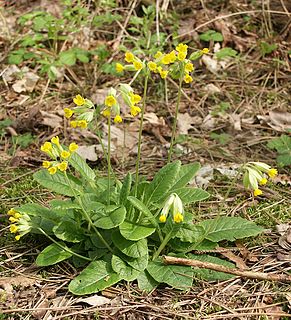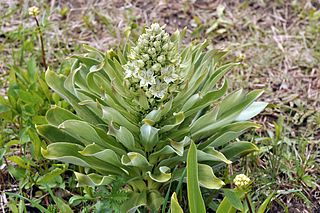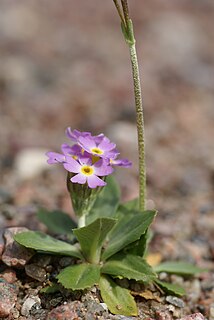
Primula is a genus of mainly herbaceous flowering plants in the family Primulaceae. They include the familiar wildflower of banks and verges, the primrose. Other common species are P. auricula (auricula), P. veris (cowslip), and P. elatior (oxlip). These species and many others are valued for their ornamental flowers. They have been extensively cultivated and hybridised. Primula are native to the temperate Northern Hemisphere, south into tropical mountains in Ethiopia, Indonesia, and New Guinea, and in temperate southern South America. Almost half of the known species are from the Himalayas.

Primula veris, the cowslip, common cowslip, or cowslip primrose, is a herbaceous perennial flowering plant in the primrose family Primulaceae. The species is native throughout most of temperate Europe and western Asia, and although absent from more northerly areas including much of northwest Scotland, it reappears in northernmost Sutherland and Orkney and in Scandinavia. This species frequently hybridizes with other Primulas such as the common primrose Primula vulgaris to form false oxlip which is often confused with true oxlip, a much rarer plant.

Primula vulgaris, the common primrose, is a species of flowering plant in the family Primulaceae, native to western and southern Europe, northwest Africa, and parts of southwest Asia. The common name is primrose, or occasionally common primrose or English primrose to distinguish it from other Primula species also called primroses. None of these are closely related to the evening primroses.

Primula lutea is a species of primrose that grows on basic rocks in the mountain ranges of southeastern Europe, including the southern and eastern Alps, southern Carpathians, Apennines, and the Balkans. The leaves are obovate and stalkless, with a cartilaginous edge, all growing in a basal rosette. The yellow flowers grow in clusters on 5–20 cm long stalks.

Primula scotica, commonly known as Scottish primrose, is a species of flowering plant in the family, Primulaceae, the primroses and their relatives. It was discovered by James Smith, and is endemic to the north coast of Scotland.

Chylismia claviformis is a species of wildflower known as browneyes or brown-eyed primrose native to North America. This species is found across western North America from the Pacific Northwest to northern Mexico.

Dodecatheon redolens, sometimes treated synonymously with Primula fragrans, has the common name scented shooting star. It is a species of flowering plant in the primrose family.

Oenothera suffrutescens is a species of flowering plant in the evening primrose family known as scarlet beeblossom and scarlet gaura.
Antennaria suffrutescens is a species of flowering plant in the daisy family known by the common names evergreen pussytoes and evergreen everlasting. It is native to southwestern Oregon and far northeastern California. It grows in coniferous forests in the mountains, sometimes on serpentine soils.
Chylismia heterochroma is a species of evening primrose known by the common name Shockley's evening primrose. It is native to the desert slopes and woodland of eastern California and Nevada. It is a hairy, glandular annual herb growing a spindly stem up to a meter tall. There is a thick basal rosette of leaves which are mostly oval in shape and several centimeters in length, and generally no leaves higher up the stem. The inflorescence produces several small flowers with four oval petals just a few millimeters long and lavender in color with yellow-tinted bases. The fruit is a club-shaped capsule roughly a centimeter long.

Taraxia tanacetifolia is a species of evening primrose known by the common name tansyleaf evening primrose. It is native to the western United States, particularly the Great Basin and the mountains of the Pacific Northwest. It is a perennial herb growing from a woody taproot and spreading via lateral shoots. It lacks a stem and takes the form of a flat rosette of hairy leaves with a central inflorescence. The frilly leaves are long and narrow, lined with deep, irregular, narrow lobes. The leaf blades are up to about 30 centimeters long and are borne on long petioles. The flowers at the center of the rosette have bright yellow petals up to about 2.3 centimeters long. The fruit is a swollen, leathery capsule containing two rows of seeds.
Boechera constancei is a species of flowering plant in the mustard family known by the common name Constance's rockcress. It is endemic to California, where it is known only from the northern Sierra Nevada of Plumas and Sierra Counties. It is a member of the serpentine soils flora. This is a perennial herb growing from a branching, woody caudex. It produces one or more erect, hairless stems to maximum heights between 15 and 30 centimeters. The caudex is surrounded by a dense basal rosette of stiff, blue-green, lance-shaped leaves up to 3 centimeters long. There may be a few smaller leaves along the stem. The inflorescence produces 5 to 10 white mustardlike flowers with protruding stamens. The fruit is a hanging green silique 4 or 5 centimeters long which contains round, winged seeds.

Lewisia leeana is a species of flowering plant in the family Montiaceae known by the common name quill-leaf lewisia. It is native to California and Oregon, where it grows in the mountains of the Sierra Nevada and Klamath Ranges. This is a perennial herb growing from narrow, woody taproot connected to one or more caudices. It produces a basal rosette of many fleshy flat to cylindrical blunt-tipped leaves up to 4 centimeters long. The inflorescence bears many flowers on erect, branching stems up to about 24 centimeters tall. Each flower has 5 to 8 white, pink, or purplish petals each about half a centimeter long.

Lewisia oppositifolia is a rare species of flowering plant in the family Montiaceae known by the common name opposite-leaf lewisia. It is native to the Klamath Mountains of Josephine County, Oregon, and Del Norte County, California, where it is a local serpentine endemic generally found in moist areas. This is a perennial herb growing from a small taproot and caudex unit. It produces a basal rosette of several lance-shaped, blunt-tipped fleshy leaves up to 11 centimeters long. There are sometimes smaller leaves located on the lower stem. The inflorescence is made up of one or more erect stems up to about 20 centimeters long, each bearing 1 to 6 flowers. The flower has 8 to 11 white to pale pink petals with blunt or jagged tips, each between 1 and 2 centimeters long. At the center are several stamens with pale anthers. This plant has a limited distribution and it is threatened by human activity in the area, such as logging.

Lewisia stebbinsii is a rare species of flowering plant in the family Montiaceae known by the common name Stebbins' lewisia. It is endemic to California, where it is known from less than fifteen sites in the Inner North Coast Ranges of Mendocino and Trinity Counties, mainly in Mendocino National Forest.

Primula sieboldii, the Japanese primrose, is a species of primrose that is endemic to East Asia. The species goes by common names such as Siebold's primrose, cherry blossom primrose, Japanese woodland primroseSnowflake, Geisha girl, Madam butterfly and the Japanese primrose which also applies to the related species Primula japonica.

Frasera speciosa is a species of flowering plant in the gentian family (Gentianaceae) known by the common names elkweed, deer's ears, and monument plant.

The flora of the U.S. Sierra Nevada alpine zone is characterized by small, low growing, cushion and mat forming plants that can survive the harsh conditions in the high-altitude alpine zone above the timber line. These flora often occur in alpine fell-fields. The Sierra Nevada alpine zone lacks a dominant plant species that characterizes it, so may or may not be called a vegetation type. But it is found above the subalpine forest, which is the highest in a succession of recognized vegetation types at increasing elevations.
Hibbertia suffrutescens is a species of flowering plant in the family Dilleniaceae and is endemic to the Northern Kimberley region of Western Australia. It is a small shrub with wiry branches, narrowly lance-shaped leaves with the narrower end towards the base, and yellow flowers arranged singly along the branches, with 30 to 36 stamens arranged in groups around two densely scaly carpels.

Primula stricta, also known as the strict primrose, is a species of flowering plant in the family Primulaceae.















